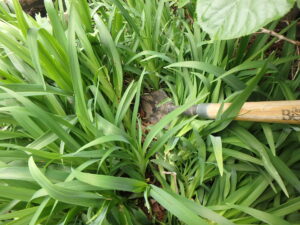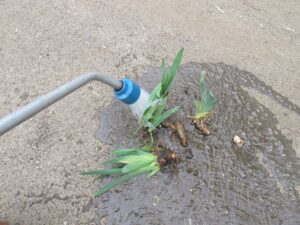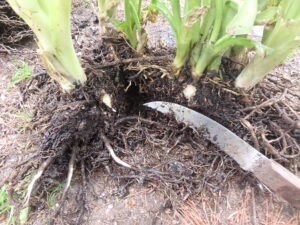How to Divide Flowers to Get More Plants – for Free!
Posted on Tuesday, May 26, 2020 · Leave a Comment
I spend a lot in plant nurseries. At $10 or more a pop, it is easy to spend a hundred dollars quick as a blink. But I’m also a firm believer in dividing my perennials so that I don’t have to spend so much. Once you have established a good plant palette, you can increase numbers by dividing plants. Don’t be afraid to give it a try.
You need to learn a little about each plant in order to know if the roots can easily be separated, allowing you to divide plants. And although horticulturists may tell you that the time of year is important, in my experience you can divide most things anytime. Peonies are supposed to be moved or divided only in the fall after they have gone dormant, but I once moved 50 peonies for a client in June and they thrived.
One way to learn about propagation is by using a good text. My bible is Manual of Herbaceous Ornamental Plants by Steven M. Stills (Stipes Press, paperback, 814 pages). Although the publisher sells new copies at $58.80, used copies are readily available for a fraction of the price.
The book tells when to divide (spring or fall) and whether plants spread easily by seed. It also gives cultural tips about where and how to plant each flower. Most common and many unusual plants are included, one or two pages on each. There are drawings for each, with a few color photos in the back.

Don’t be afraid to cut through leaves or roots when dividing a big patch of daylilies
Another way to learn about dividing plants is to just do it. Dig up a plant and examine the roots. I use a drain spade to do this. A drain spade is a pointed shovel with a long, narrow blade (commonly 6 inches wide and 16 inches long). I plunge it into the soil and pry back a little. Then I repeat the procedure on all sides. When the plant is loose, I lift it out.
Some plants have long, deep roots. Others, such as peonies, have roots that look like tubers. Most have lots of string-like roots going in all directions. If the bed you are working in is full of weeds, it is important to distinguish between grass or weed roots and those of your plant. Observe the color and texture of the plant roots and remove any roots that are different. Daylily roots, for example are very distinctive in both color and shape.

Barerooting with a hose will ensure you have no weed roots
When dividing a plant, you may wish to actually bare-root it. Do this by shaking off any soil attached, or washing the root system with a hose to remove the soil. Weed or grass roots will be obvious when you do that. I normally do that for any gifted plants because I want to avoid getting any invasive weeds that might come with it. I learned that lesson the hard way, having accepted some nice iris plants that had goutweed roots embedded that then have plagued me for 30 years.
If all the roots are attached to a single stem, you cannot divide the plant. But most plants are not like that. You can usually tease the roots apart, taking sections of the clump apart. Each chunk will give you a nice plant.
Hostas are common shade plants with lovely foliage. They do produce white flowers in mid-summer, but most people grow them for the foliage. Big clumps commonly are created as the plant expands, roots sending up new plants. Dig up a big clump, and you might get a dozen plants – or more.

Dividing hostas roots with a serrated knife is easy
I was dividing some hostas recently, and found some clumps hard to pull apart. So I used a curved, serrated knife to cut through some roots, allowing me to separate them. If you don’t have a garden knife, buy a steak knife at a yard sale or junk shop – on sneak one out of the kitchen – and it will work just fine.
And then I wanted to move some common orange daylilies. These send out long roots, which then send up new plants, so one plant can become many just in the time it takes to get a bottle of orange pop from the kitchen. Or a year to two.
With the daylilies, I used a shovel to cut through the roots between plants to get them into clumps of a manageable size. Don’t worry about damaging roots or leaves, these puppies are indestructible. Just dig up, cut apart and move.
For spring blooming plants, digging now may hinder flowering this year. For fall blooming plants, that is less of a problem. Some plants benefit by digging, dividing and fertilizing. Steven Stills’ book mentions how often to do that: for purple cone flower, for example, it is every 4 years. For Shasta daisies, every other spring is best. And so on.
Always choose a cool, cloudy day for dividing plants. Even a drizzly day. Plants can go into shock if divided at noon on a hot day. I like to do it in the evening when rain is in the forecast.
The great thing about digging up a big perennial is not only that you have more plants: your friends will, too. I often put a blurb in my town list serve offering free plants. I’ve made some very nice friends that way!
Henry is now teaching Zoom classes to gardening clubs and libraries. Contact him at
henry.homeyer@comcast.net. He is the author of 4 gardening books.





